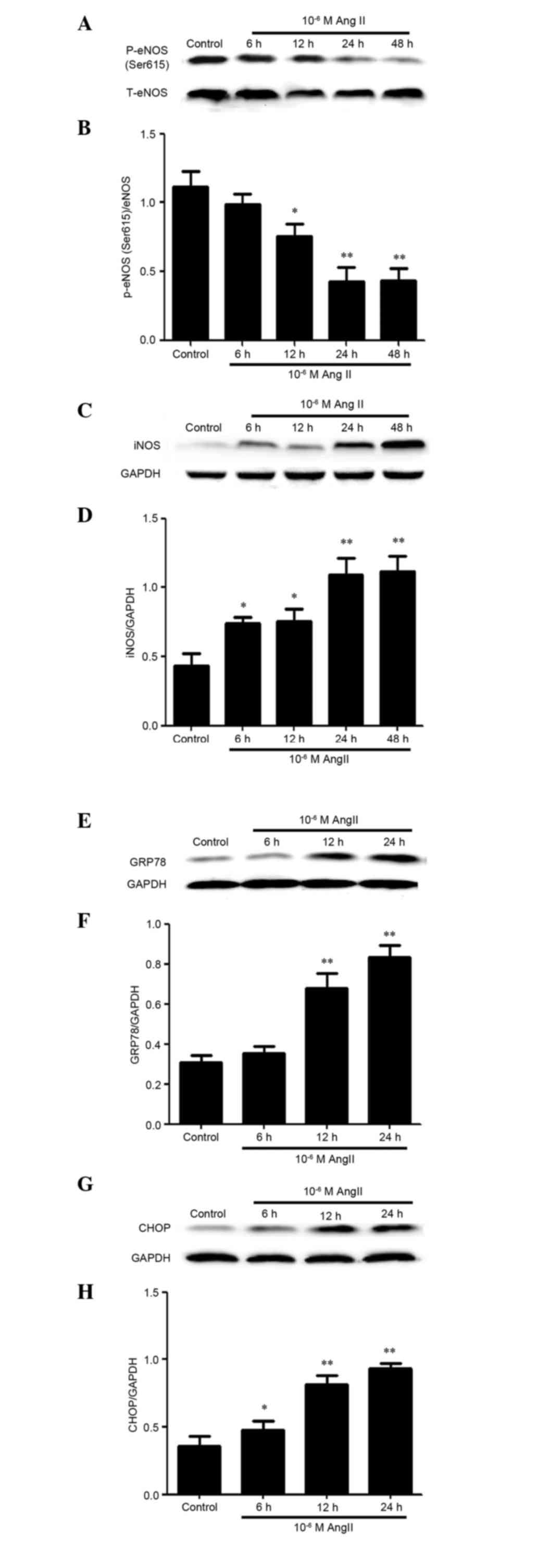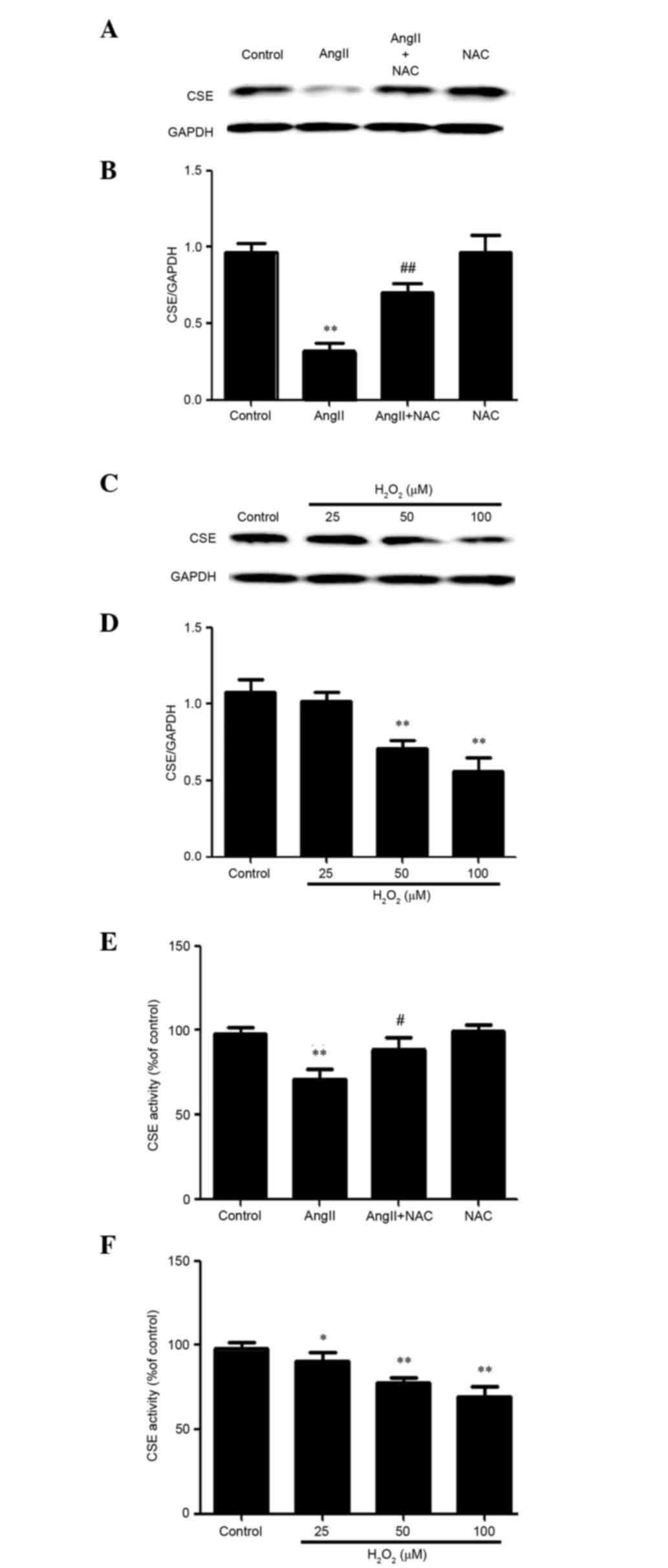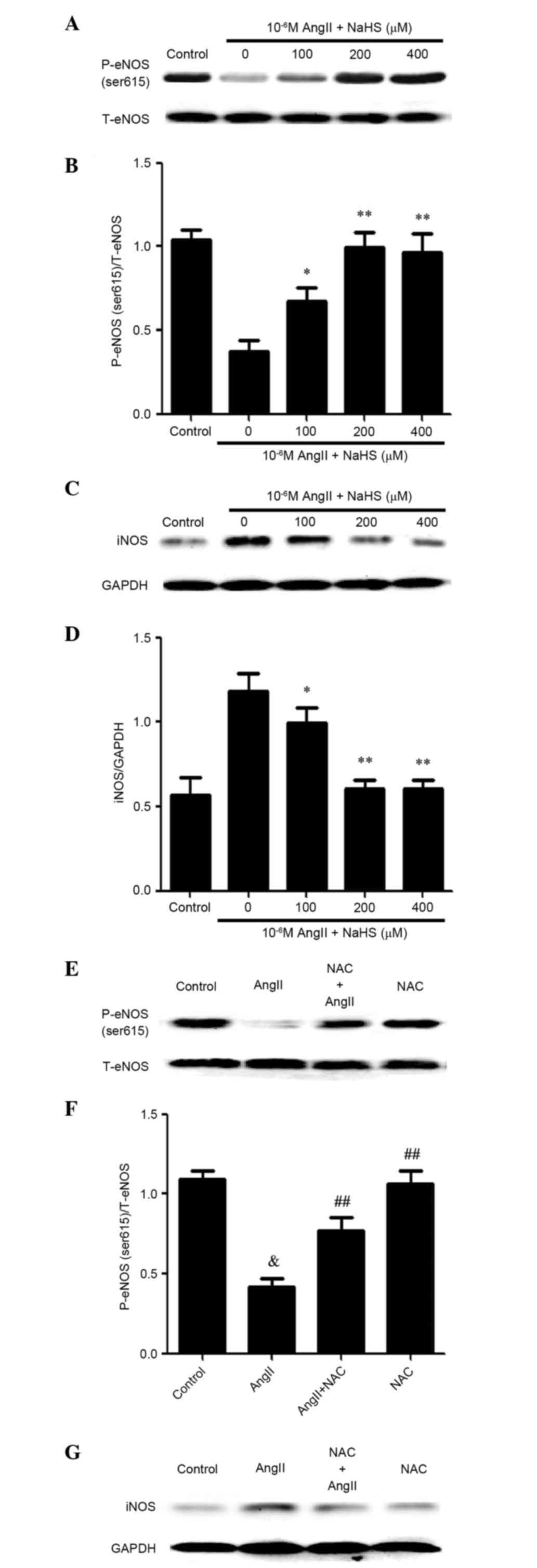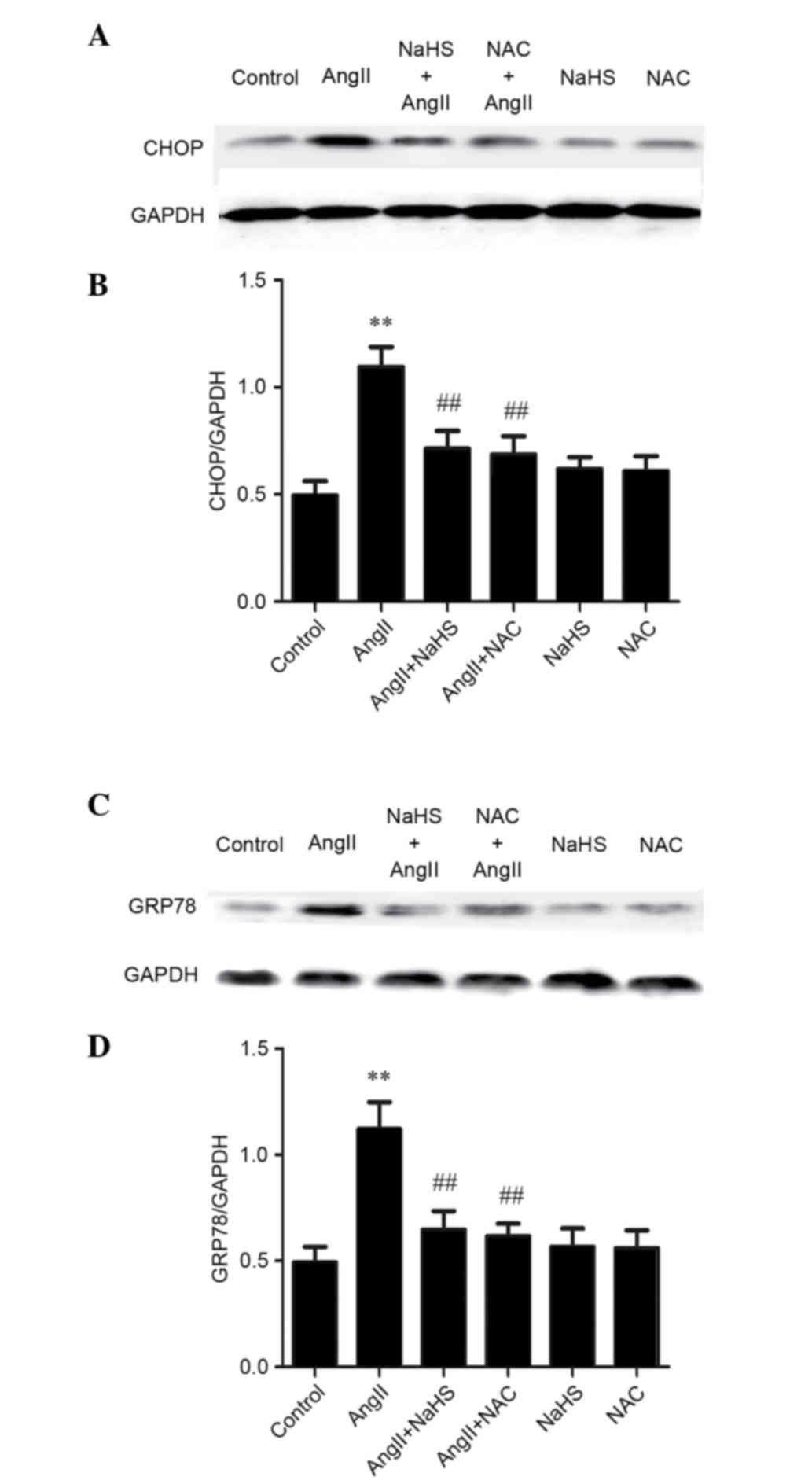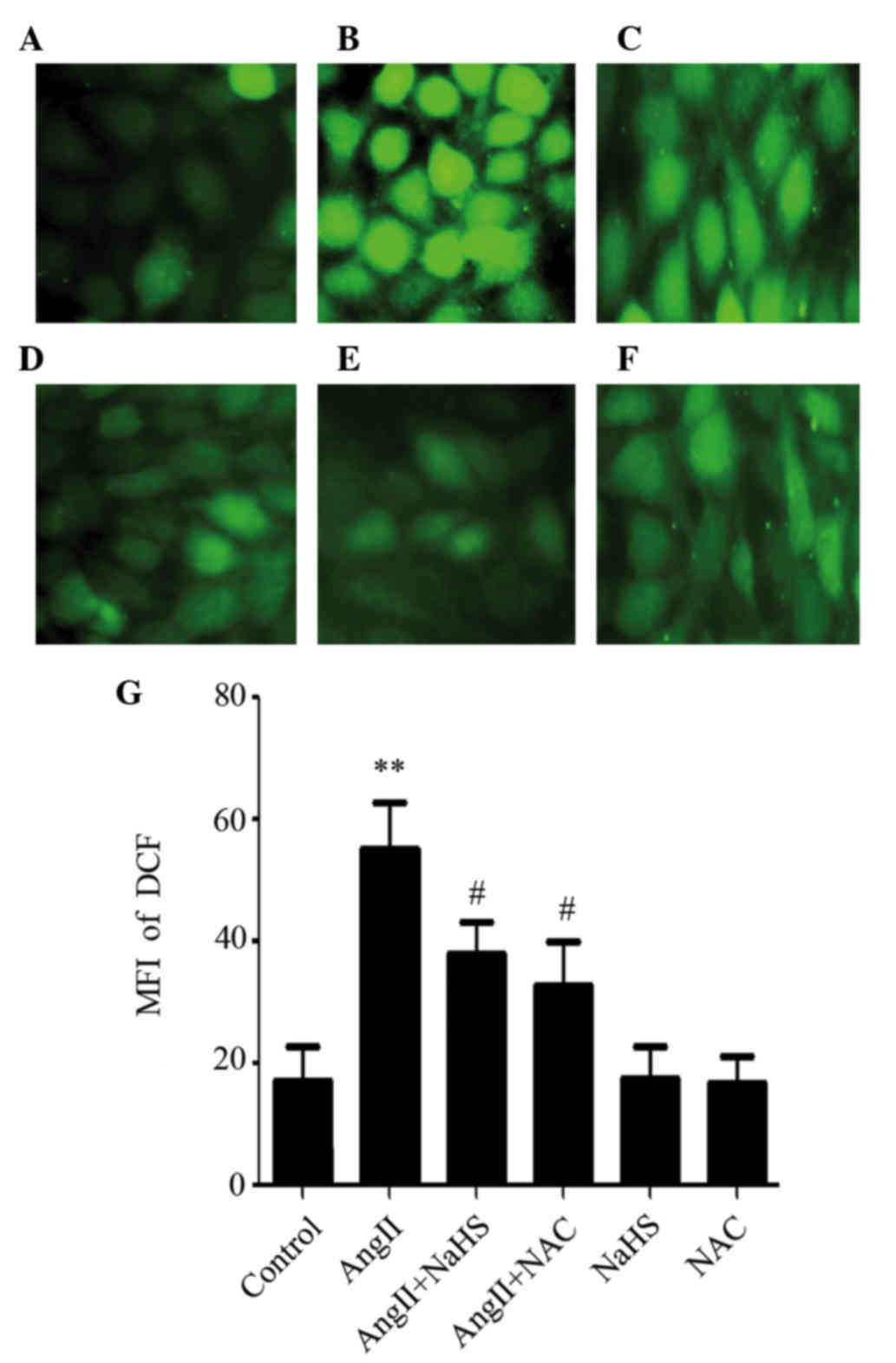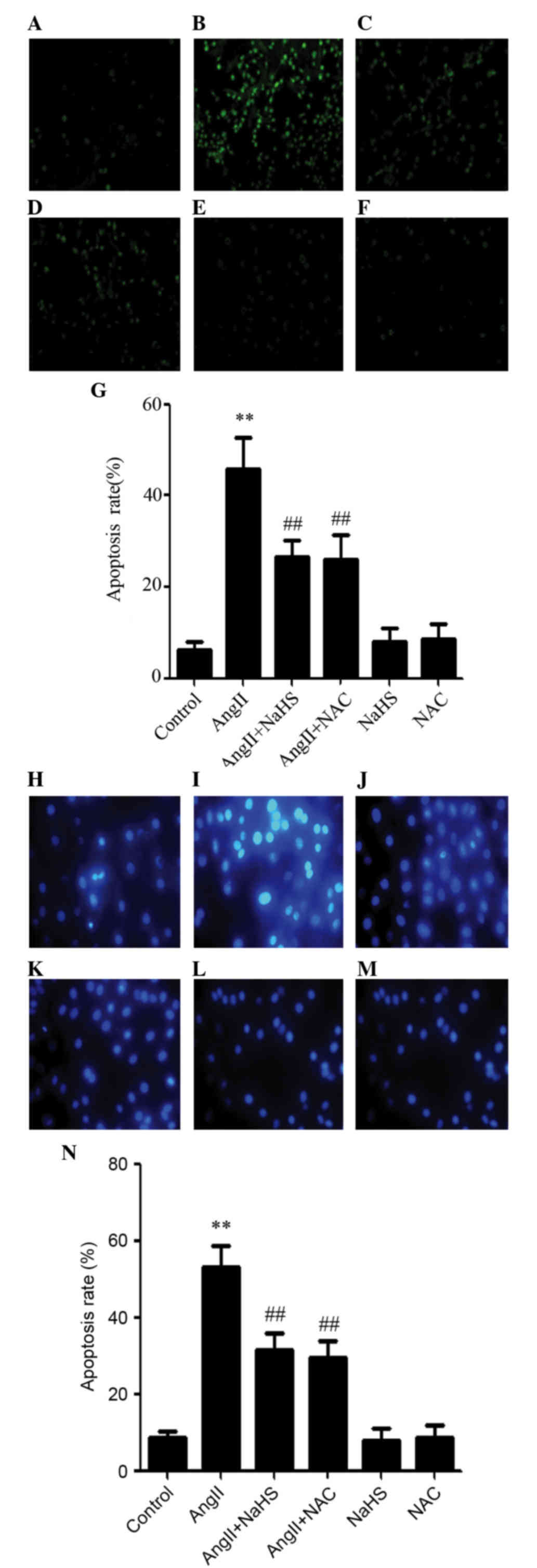Protective effects of hydrogen sulfide against angiotensin II-induced endoplasmic reticulum stress in HUVECs
- Authors:
- Published online on: February 22, 2017 https://doi.org/10.3892/mmr.2017.6238
- Pages: 2213-2222
Abstract
Introduction
The pathogenesis of cardiovascular disease (CVD) and cardiovascular complications, such as atherosclerosis, is associated with endothelial dysfunction (ED) (1,2). It is well established that ED contributes to the high rates of cardiovascular mortality (3). Excessive oxidative stress, particularly reactive oxygen species (ROS), exerts a diverse atherogenic effect that induces vascular and tissue injuries (4), which are considered to serve an important role in the development of ED.
The renin-angiotensin system (RAS) has long been known to have an important role in the maintenance of cardiovascular function, and electrolyte and fluid balance. Emerging evidence has suggested that angiotensin II (AngII) is a marker of the RAS system, and higher AngII levels correlate with a higher incidence of CVD (5). Furthermore, AngII has been shown to directly regulate vascular resistance and induce cardiac fibrosis-associated gene expression in a mouse model of cardiac dysfunction (6). It has also been hypothesized that overproduction of AngII participates in the progression of CVD via ROS (7). Furthermore, in model rats with hypertensive disease, AngII levels were much higher in endothelial cells compared with in plasma (8). Beyond vasoconstriction, previous studies have demonstrated that AngII exerts cytotoxic effects via the induction of apoptotic endothelial cell death, these effects were associated with phosphorylated-endothelial nitric oxide synthase (p-eNOS) and inducible nitric oxide synthase (iNOS) in a concentration-dependent manner (9–12). Notably, p-eNOS and iNOS have been indicated as biomarkers and novel therapeutic targets in oxidative stress-associated ED (12–15).
The endoplasmic reticulum (ER) is a subcellular organelle in which protein translation, folding and trafficking occur. In addition, inflammation generated by ER stress is cytotoxic to several cell types, and may facilitate the progression of ED. Previous studies have demonstrated that increased ER stress levels are a marker for cardiovascular risk, and are associated with higher levels of oxidative stress and hypoxia (16,17). In addition, numerous studies have reported that several conditions, such as diabetes mellitus and cardiovascular disorders, are correlated with increased ER stress levels (18,19). Glucose-regulated protein 78 (GRP78) and C/EBP-homologous protein (CHOP) are biological markers for ER stress (20,21). Furthermore, ER stress is associated with decreased p-eNOS expression (14,22).
A previous study demonstrated that AngII induces ED via ER stress (23). In addition, increased levels of GRP78 and CHOP have been reported to correlate with vascular ED, and decrease the activity of antioxidant enzymes, such as eNOS, in AngII-treated mice, thus suggesting that AngII-induced ED is associated with ER stress (23,24). Hydrogen sulfide (H2S) can attenuate ER stress by increasing superoxide dismutase expression and reducing ROS levels (25). Furthermore, H2S may attenuate RAS activation via reduced ROS overproduction (26). The present study hypothesized that H2S exerts cytoprotective effects against AngII-induced ED in human umbilical vein endothelial cells (HUVECs) via the inhibition of ER stress.
It has previously been demonstrated that H2S exerts cytoprotective effects against oxidative stress-induced endothelial cell injury via antioxidant defense mechanisms (27). However, to the best of our knowledge, no previous studies have verified whether H2S has any effect on AngII-induced ER stress and ED in HUVECs.
In the present study, HUVECs were treated with AngII to establish a cellular model of ED, and the effects of AngII on ER stress, which is considered a main cause of ED development, were detected. Furthermore, the protective effects of H2S on AngII-induced ER stress were investigated. The effects of H2S on AngII-induced apoptosis and ROS accumulation were also determined, which are important processes in the development of ED.
Materials and methods
Materials
Dulbecco's modified Eagle's medium (DMEM) and fetal bovine serum (FBS) were obtained from Gibco (Thermo Fisher Scientific, Inc., Waltham, MA, USA). Sodium hydrosulfide (NaHS), AngII, N-acetyl-L-cysteine (NAC), Hoechst 33258, deoxynucleotidyl transferase-mediated dUTP-biotin nick end labeling (TUNEL) and 2′,7-dichlorodihydrofluorescein diacetate (DCFH-DA) were purchased from Sigma-Aldrich (Merck Millipore, Darmstadt, Germany). Antibodies targeting iNOS (cat. no. ab15323), p-eNOS (cat. no. ab183046), GRP78 (cat. no. ab21685) and CHOP (cat. no. ab11419), p-eNOS (cat. no. ab183046), GAPDH (cat. no. ab8245) and caspase-12 (cat. no. ab62484) were provided by Abcam (Cambridge, UK). Cystathionine-c-lyase (CSE) antibody was purchased from by Proteintech Group Inc. (Rosemont, IL, USA; cat. no. 12032-1-AP). Cell Counting kit-8 (CCK-8) was obtained from Dojindo China Co., Ltd. (Shanghai, China). Horseradish peroxidase-conjugated IgG (H+L) secondary antibodies were purchased from Beyotime Institute of Biotechnology (Shanghai, China; cat. nos. A0192 and A0208). All other reagents, unless specified, were purchased from Beyotime Institute of Biotechnology.
Cell culture
HUVECs (Cell Bank of the Type Culture Collection of the Chinese Acadmy of Sciences, Shanghai, China) were cultured in DMEM supplemented with 10% FBS at 37°C in a humidified atmosphere containing 5% CO2. Prior to each experiment, the medium was replaced with fresh serum-containing medium unless otherwise indicated. Cells were divided into the following treatment groups: i) Untreated; ii) AngII, consisting of 1×106 HUVEC cells treated with 10−6 M AngII for 0–24 h; iii) NaHS + AngII, consisting of 1×106 HUVEC cells exposed to 200 µM NaHS for 60 min prior to treatment with 10−6 M AngII for 24 h; iv) NAC + AngII, consisting of 1×106 HUVEC cells exposed to 100 µM NAC for 60 min prior to treatment with 10−6 M AngII for 24 h; v) NaHS, consisting of 1×106 HUVEC cells exposed to 200 µM NaHS for 24 h; and vi) NAC, consisting of 1×106 HUVEC cells exposed to 100 µM NAC for 24 h.
Cell viability assay
After the HUVECs were cultured in 96-well plates and had received various treatments, 100 µl CCK-8 was added to each well at a 1/10 dilution, and the eight plates were incubated for a further 2 h at 37°C. Absorbance was then measured at 450 nm using a microplate reader. The mean optical density (OD) of four wells in the indicated groups was used to calculate the percentage of cell viability, according to the following formula: Cell viability (%) = OD treatment group / OD control group × 100%.
Detection of intracellular ROS generation
After the HUVECs were cultured in 96-well plates and had received various treatments, 10 µmol/l DCFH-DA in serum-free DMEM was added to each well and incubated for a further 30 min at 37°C. The cells were then washed three times with serum-free DMEM prior to the detection of dichlorofluorescein fluorescence. A fluorescent microscope connected to an imaging system was used to observe the entire field of vision. Mean fluorescence intensity (MFI) from three random fields was analyzed using ImageJ 1.41o software (National Institutes of Health, Bethesda, MD, USA); MFI was used to represent the amount of ROS.
Measurement of CSE activity
After receiving the various treatments, HUVECs were collected and homogenized in 50 mM ice-cold potassium phosphate buffer (pH 6.8). The reaction mixture contained 100 mmol/l potassium phosphate buffer (pH 7.4), 10 mmol/l L-cysteine, 2 mmol/l pyridoxal 5′-phosphate and 10% (w/v) homogenate. Cryovial test tubes (2 ml) were used as the center wells, into which 0.5 ml 1% zinc acetate was added as the trapping solution and 2×2.5 cm filter paper was used to increase air:liquid contact surface. The reactions were performed in Erlenmeyer flasks. The flasks containing the reaction mixture and the center wells were flushed with N2, before being sealed with a double layer of parafilm. The reactions were initiated by transferring the flasks from ice to a 37°C shaking water bath. Following a 90 min incubation at 37°C, 0.5 ml of 50% trichloroacetic acid was added to terminate the reaction. The flasks were then resealed and incubated at 37°C for a further 60 min to ensure the complete trapping of H2S released from the mixture. The contents of the center wells were transferred to test tubes, each containing 3.5 ml water. Subsequently, 0.5 ml 20 mM N,N-dimethyl-p-phenylenediamine sulphate in 7.2 M HCl was added, immediately followed by the addition of 0.5 ml 30 mM FeCl3 in 1.2 M HCl. After 20 min, the absorbance of the resultant solution was measured at 670 nm using a spectrophotometer.
Western blot analysis
After the indicated treatments, the cells were washed three times with PBS and were collected according to the cell suspension method. The cells were then lysed in lysis buffer on ice for 30 min. The resulting cell lysates were clarified by centrifugation at 10,943 × g for 15 min at 4°C. Proteins were quantified using the bicinchoninic acid method.
Total proteins (300 ng) were separated by 10% SDS-PAGE and were electroblotted onto polyvinylidene fluoride membranes. The membranes were blocked with 5% (w/v) non-fat dry milk containing 0.1% (v/v) Tween 20 for 1 h, and were then incubated with GRP78 (1:800), CHOP (1:2,000), p-eNOS (Ser615; 1:1,000), iNOS (1:1,000), CSE (1:1,000) and caspase-12 (1:2,000) antibodies overnight at 4°C. Subsequently, secondary antibodies (1:1,000) were incubated for 1 h at room temperature. Membranes were visualized using an enhanced chemiluminescence kit according to the manufacturer's protocols (Beyotime Institute of Biotechnology) and relative protein expression levels were semi-quantitively analyzed by densitometry using QuantityOne software (version 4.62; Bio-Rad Laboratories, Inc., Hercules, CA, USA).
Determination of HUVEC apoptosis
The apoptosis of HUVECs was detected using TUNEL and Hoechst 33258 staining. TUNEL staining was performed using an In Situ Cell Death Detection kit, according to the manufacturer's protocol. Briefly, after the indicated treatments, cells were fixed with 4% paraformaldehyde in PBS for 10 min. After three washes in PBS, the cells were stained with 50 µl TUNEL dye for 1 h, after which the cells were rinsed briefly with PBS and were air-dried. Subsequently, the cells were visualized under a florescence microscope. Apoptotic cells with condensed nuclei exhibited green fluorescence, whereas viable cells displayed normal nuclear size and uniform florescence.
Hoechst 33258 staining was also conducted
Briefly, after the indicated treatments, cells were fixed with 4% paraformaldehyde in PBS for 10 min. After three washes in PBS, cells were stained with 5 mg/l Hoechst 33258 dye for 10 min before being rinsed briefly with PBS and air-dried. The cells were then visualized under a florescence microscope. Apoptotic cells with condensed nuclei exhibited blue fluorescence, whereas viable cells displayed normal nuclear size and uniform florescence. The ratios of different fluorescent densities from 4 random fields was analyzed using ImageJ (version 1.41o; imagej.nih.gov/ij/). The experiment was repeated 3 times.
Statistical analysis
Data are presented as the mean ± standard error of the mean. Differences between groups were analyzed by one-way analysis of variance followed by Bonferroni's correction. Data were analyzed using SPSS 15.0 (SPSS, Inc., Chicago, IL, USA). P<0.05 was considered to indicate a statistically significant difference.
Results
AngII induces cytotoxicity and ER stress by inhibiting the expression and activity of CSE in HUVECs
iNOS and phosphorylation of eNOS (ser615) (an essential step in eNOS activation) have been reported to be involved in AngII cytotoxicity (28,29) and ED (30). Therefore, the present study investigated whether AngII could induce ED through alterations in the expression levels of p-eNOS (ser615) and iNOS in HUVECs. As presented in Fig. 1, untreated HUVECs failed to produce detectable levels of iNOS, whereas AngII-treated cells produced high levels of iNOS. Conversely, the other ED marker, p-eNOS (ser615), was reduced in AngII-treated cells. ER stress has been reported to be associated with AngII in mice (31,32); therefore, the present study further observed the effects of AngII on the expression of ER stress-associated molecules, such as GRP78 and CHOP. Similar to iNOS, AngII was able to induce GRP78 and CHOP expression. Conversely, CSE expression and activity was reduced in a time-dependent manner following AngII treatment.
Stimulation of ROS production inhibits the expression and activity of CSE in AngII-treated HUVECs
Oxidative stress, which is generated by AngII, can induce endothelial cell injury (33). Since AngII can induce ROS production, the present study aimed to determine the mechanism underlying ROS production in AngII-treated HUVECs. As presented in Fig. 2, HUVECs pretreated with NAC before AngII exhibited increased CSE expression and activity compared with cells treated with AngII. In addition, a well-known exogenous ROS, hydrogen peroxide (H2O2), was used to determine whether ROS induced the downregulation of CSE expression and activity. H2O2-treated HUVECs exhibited almost undetectable CSE expression and activity compared with untreated control cells. These data indicate that AngII-induced ROS may contribute to the downregulatory effects of AngII on the expression and activity of CSE in HUVECs.
Exogenous H2S ameliorates AngII-induced ED mediated by ROS in HUVECs
The present study demonstrated that AngII can inhibit activation of the CSE/H2S pathway in AngII-treated HUVECs; therefore, the present study used a well-known endothelial protective agent, NaHS, to determine whether NaHS could reduce AngII-induced ED. As presented in Fig. 3, cells treated with NaHS and AngII had lower levels of iNOS, compared with NaHS-unstimulated AngII-treated cells. Conversely, NaHS markedly ameliorated AngII-reduced p-eNOS (ser615) expression. The results suggest that treatment with 200 or 400 µM NaHS may inhibit AngII-induced ED. Similarly, treatment with NAC significantly ameliorated the expression levels of AngII-suppressed p-eNOS (ser615) (Fig. 3E and F) and AngII-enhanced iNOS (Fig. 3G and H). Notably, cells treated with either NaHS or NAC alongside AngII exhibited improved cell viability compared with AngII-treated cells, whereas treatment with either NaHS or NAC alone did not alter cell viability in HUVECs (Fig. 3I). These data indicate that antioxidants may mediate the effects of H2S on AngII-induced ED.
H2S supplementation or NAC ameliorates AngII-stimulated GRP78 and CHOP overexpression in HUVECs
The present study detected the potential mechanism underlying the protective effects of H2S against AngII-induced ED in HUVECs. It has previously been demonstrated that ROS may induce ER stress. The present results indicated that treatment with the antioxidants NaHS or NAC could suppress AngII-induced GRP78 and CHOP expression, whereas either NaHS or NAC alone did not alter the expression levels of GRP78 and CHOP in HUVECs (Fig. 4). These data suggest that the inhibitory effects of H2S may protect against AngII-induced dysfunction in HUVECs via suppressing ER stress.
H2S supplementation or NAC ameliorates AngII-induced ROS generation in HUVECs
To determine whether the cytoprotective effects of H2S against AngII-induced ED were due to its antioxidative activity, NaHS and NAC were used to treat HUVECs. AngII exposure markedly enhanced intracellular ROS generation in HUVECs (Fig. 5B). However, pretreatment with either NaHS or NAC for 60 min markedly attenuated AngII-induced ROS accumulation in HUVECs (Fig. 5C and D). Pretreatment with NAC had a similar antioxidant effect to NaHS against AngII-induced ROS accumulation, whereas NaHS or NAC treatment alone did not alter base intracellular ROS levels (Fig. 5E and F).
Exogenous H2S and NAC reduce AngII-induced apoptosis in HUVECs
The present study also determined the effects of NaHS and NAC on AngII-induced apoptosis. As shown in Fig. 6, AngII-stimulated HUVECs exhibited typical characteristics of apoptosis, including chromatin condensation, nuclear shrinkage, and the presence of apoptotic bodies. However, treatment with either NaHS or NAC, alongside AngII, resulted in amelioration of the typical characteristics of apoptosis, including chromatin condensation, nuclear shrinkage, and the presence of apoptotic bodies compared with in cells treated with AngII only. Treatment with NaHS or NAC alone did not markedly alter cell morphology or the percentage of apoptotic HUVECs. Consistent with these results, the protein expression levels of cleaved caspase-12 were examined by western blot analysis, and were reduced in AngII-treated cells following NaHS or NAC treatment. However, treatment with either NaHS or NAC alone did not alter the expression of cleaved caspase-12. These findings indicate that exogenous H2S protects HUVECs against AngII-induced ER stress.
Discussion
RAS activity and oxidative stress are two major interacting pathogenic factors associated with ED, which is the initiating factor and pathological basis of CVD (34,35). As an important mediator of endothelial function maintenance, reduced levels of nitric oxide (NO) could accelerate the ED process (36). Cellular and animal studies have demonstrated that NO, via constitutive NOS isoforms, modulates endothelial cell dilation and blood flow distribution, and low levels of p-eNOS activity are associated with injured endothelial function (37,38). However, high levels of iNOS also exert a similar effect (39). Nakao et al (40) demonstrated that suppressed p-eNOS and enhanced iNOS expression are associated with AngII cytotoxicity; together with the present findings, these results suggested that AngII may result in HUVECs dysfunction.
Emerging evidence from experimental and clinical research has indicated that ER stress is involved in CVD with ED (41) and RAS activity (42). ER stress modulates various factors, including GRP78 and CHOP. Oxidative stress (43) or AngII stimulation (44) have been suggested to trigger GRP78 and CHOP overexpression. Furthermore, AngII can upregulate the expression of inflammatory mediators, including GRP78 and CHOP, leading to cytotoxicity in HUVECs. The present findings are in agreement with those of a previous study, which demonstrated that high levels of AngII led to cardiac damage and vascular ED via ER stress (23). CSE serves atherogenic and endothelial cytoprotective roles in CVD (27,45). Conversely, AngII exerts cytotoxic effects, and in the present study AngII was shown to downregulate the expression and activity of CSE in HUVECs, which was accompanied by decreased cell viability. In addition, insufficient production of endogenous H2S or inhibition of its synthesis have been reported to enhance the overproduction of ROS in HUVECs (46). Taken together, it may be hypothesized that AngII-induced ER stress leads to ED in HUVECs via the inhibition of endogenous H2S production.
Insufficient production of endogenous H2S has been reported to be associated with AngII-induced cytotoxicity via oxidative stress (47). The present study, alongside a previous study, confirmed that ROS, such as H2O2, serve a primary role in ER stress, are regulated by AngII and are responsible for the consequent generation of ED (48). Furthermore, the present study demonstrated that treatment with the exogenous ROS, H2O2, downregulated the expression and activity of CSE; the inhibitory effects of H2O2 were similar to those of AngII in HUVECs. Subsequently, HUVECs were treated with NAC prior to AngII exposure; the results demonstrated that NAC suppressed overproduction of ROS and insufficient productions of endogenous H2S. These findings suggested that ROS serves a key role in the inhibition of CSE induced by AngII in HUVECs.
The present study also demonstrated that the effects of exogenous H2S on AngII-induced ED were due to antioxidative mechanisms. The findings indicated that H2S supplementation prior to AngII treatment in HUVECs resulted in a reduction in the expression levels of iNOS, an increase in p-eNOS (Ser615) expression and increased cell viability. Furthermore, treatment with NAC before AngII exposure not only exerted inhibitory effects on iNOS expression, but also enhanced p-eNOS (Ser615) expression and cell viability, whereas supplementation of H2S (NaHS) prior to AngII-treated HUVECs had similar effects. The present study further explored the potential mechanism underlying the protective effects of exogenous H2S, by treating cells with either NaHS or NAC prior to AngII exposure. Since NaHS or NAC exert similar antioxidative effects, NAC, similar to NaHS, was able to reduce ER stress, including GRP78 and CHOP expression. In addition, DCFH-DA was used to detect cellular ROS accumulation. The results indicated that the antioxidative effects of H2S may exert protection against AngII-induce ED by suppressing ER stress. ROS are associated with accelerated ER malfunction (49); the present study demonstrated that in HUVECs pretreated with NaHS or NAC prior to AngII exposure, ROS overproduction was inhibited.
ER stress is particularly associated with apoptosis. Song et al (50) demonstrated that GRP78 and CHOP are markedly activated in apoptosis. The present study pretreated HUVECs with NaHS or NAC, prior to AngII exposure, and TUNEL and Hoechst 33258 staining were used to detect apoptosis. The results indicated that pretreatment with either NaHS or NAC significantly decreased AngII-induced apoptosis and cleaved caspase-12 expression. In addition, Qabazard et al (51) reported that H2S significantly suppressed H2O2-induced ER stress in bovine aortic endothelial cells, and ameliorated cell apoptosis.
In conclusion, using AngII-treated HUVECs, the present study demonstrated that ROS participates in AngII-induced ER stress-mediated ED, by inhibiting the expression and activity of CSE. In addition, H2S supplementation may be considered a beneficial antioxidative therapy in AngII-induced ED via the suppression of ER stress. The results of the present study provide novel evidence to suggest that exogenous H2S may be considered a novel therapeutic strategy for the treatment of CVD.
Acknowledgements
The present study was supported by the National Natural Science Foundation of China (grant no. 81100106), Aid Programme for Science and Technology Innovative Research Team.
References
|
Ding Z, Liu S, Wang X, Dai Y, Khaidakov M, Romeo F and Mehta JL: LOX-1, oxidant stress, mtDNA damage, autophagy, and immune response in atherosclerosis. Can J Physiol Pharmacol. 92:524–530. 2014. View Article : Google Scholar : PubMed/NCBI | |
|
Messner B and Bernhard D: Smoking and cardiovascular disease: Mechanisms of endothelial dysfunction and early atherogenesis. Arterioscler Thromb Vasc Biol. 34:509–515. 2014. View Article : Google Scholar : PubMed/NCBI | |
|
Stam F, van Guldener C, Becker A, Dekker JM, Heine RJ, Bouter LM and Stehouwer CD: Endothelial dysfunction contributes to renal function-associated cardiovascular mortality in a population with mild renal insufficiency: The Hoorn study. J Am Soc Nephrol. 17:537–545. 2006. View Article : Google Scholar : PubMed/NCBI | |
|
Geronikaki AA, Pitta EP and Liaras KS: Thiazoles and thiazolidinones as antioxidants. Curr Med Chem. 20:4460–4480. 2013. View Article : Google Scholar : PubMed/NCBI | |
|
Wang X, Yuan B, Dong W, Yang B, Yang Y, Lin X and Gong G: Humid heat exposure induced oxidative stress and apoptosis in cardiomyocytes through the angiotensin II signaling pathway. Heart Vessels. 30:396–405. 2015. View Article : Google Scholar : PubMed/NCBI | |
|
Li L, Li N, Pang W, Zhang X, Hammock BD, Ai D and Zhu Y: Opposite effects of gene deficiency and pharmacological inhibition of soluble epoxide hydrolase on cardiac fibrosis. PLoS One. 9:e940922014. View Article : Google Scholar : PubMed/NCBI | |
|
Johar S, Cave AC, Narayanapanicker A, Grieve DJ and Shah AM: Aldosterone mediates angiotensin II-induced interstitial cardiac fibrosis via a Nox2-containing NADPH oxidase. FASEB J. 20:1546–1548. 2006. View Article : Google Scholar : PubMed/NCBI | |
|
Kittikulsuth W, Looney SW and Pollock DM: Endothelin ET(B) receptors contribute to sex differences in blood pressure elevation in angiotensin II hypertensive rats on a high-salt diet. Clin Exp Pharmacol Physiol. 40:362–370. 2013. View Article : Google Scholar : PubMed/NCBI | |
|
Marrachelli VG, Mastronardi ML, Sarr M, Soleti R, Leonetti D, Martínez MC and Andriantsitohaina R: Sonic hedgehog carried by microparticles corrects angiotensin II-induced hypertension and endothelial dysfunction in mice. PLoS One. 8:e728612013. View Article : Google Scholar : PubMed/NCBI | |
|
Schäfer SC, Pellegrin M, Wyss C, Aubert JF, Nussberger J, Hayoz D, Lehr HA and Mazzolai L: Intravital microscopy reveals endothelial dysfunction in resistance arterioles in Angiotensin II-induced hypertension. Hypertens Res. 35:855–861. 2012. View Article : Google Scholar : PubMed/NCBI | |
|
Lin LY, Lin CY, Su TC and Liau CS: Angiotensin II-induced apoptosis in human endothelial cells is inhibited by adiponectin through restoration of the association between endothelial nitric oxide synthase and heat shock protein 90. FEBS Lett. 574:106–110. 2004. View Article : Google Scholar : PubMed/NCBI | |
|
Matsumoto S, Shimabukuro M, Fukuda D, Soeki T, Yamakawa K, Masuzaki H and Sata M: Azilsartan, an angiotensin II type 1 receptor blocker, restores endothelial function by reducing vascular inflammation and by increasing the phosphorylation ratio Ser (1177)/Thr(497) of endothelial nitric oxide synthase in diabetic mice. Cardiovasc Diabetol. 13:302014. View Article : Google Scholar : PubMed/NCBI | |
|
FT IV Billings, Pretorius M, Schildcrout JS, Mercaldo ND, Byrne JG, Ikizler TA and Brown NJ: Obesity and oxidative stress predict AKI after cardiac surgery. J Am Soc Nephrol. 23:1221–1228. 2012. View Article : Google Scholar : PubMed/NCBI | |
|
Matsumoto T, Kobayashi T and Kamata K: Relationships among ET-1, PPARgamma, oxidative stress and endothelial dysfunction in diabetic animals. J Smooth Muscle Res. 44:41–55. 2008. View Article : Google Scholar : PubMed/NCBI | |
|
Xing S, Yang X, Li W, Bian F, Wu D, Chi J, Xu G, Zhang Y and Jin S: Salidroside stimulates mitochondrial biogenesis and protects against H2O2-induced endothelial dysfunction. Oxid Med Cell Longev. 2014:9048342014. View Article : Google Scholar : PubMed/NCBI | |
|
Kei A, Tellis C, Liberopoulos E, Tselepis A and Elisaf M: Effect of switch to the highest dose of rosuvastatin versus add-on-statin fenofibrate versus add-on-statin nicotinic acid/laropiprant on oxidative stress markers in patients with mixed dyslipidemia. Cardiovasc Ther. 32:139–146. 2014. View Article : Google Scholar : PubMed/NCBI | |
|
Bozaykut P, Sozen E, Yazgan B, Karademir B and Kartal-Ozer N: The role of hypercholesterolemic diet and vitamin E on Nrf2 pathway, endoplasmic reticulum stress and proteasome activity. Free Radic Biol Med. 75 Suppl 1:S242014. View Article : Google Scholar : PubMed/NCBI | |
|
Hasnain SZ, Prins JB and McGuckin MA: Oxidative and endoplasmic reticulum stress in β-cell dysfunction in diabetes. J Mol Endocrinol. 56:R33–R54. 2016. View Article : Google Scholar : PubMed/NCBI | |
|
Cimellaro A, Perticone M, Fiorentino TV, Sciacqua A and Hribal ML: Role of endoplasmic reticulum stress in endothelial dysfunction. Nutr Metab Cardiovasc Dis. 26:863–871. 2016. View Article : Google Scholar : PubMed/NCBI | |
|
Simon-Szabó L, Kokas M, Mandl J, Kéri G and Csala M: Metformin attenuates palmitate-induced endoplasmic reticulum stress, serine phosphorylation of IRS-1 and apoptosis in rat insulinoma cells. PLoS One. 9:e978682014. View Article : Google Scholar : PubMed/NCBI | |
|
Wang XY, Yang CT, Zheng DD, Mo LQ, Lan AP, Yang ZL, Hu F, Chen PX, Liao XX and Feng JQ: Hydrogen sulfide protects H9c2 cells against doxorubicin-induced cardiotoxicity through inhibition of endoplasmic reticulum stress. Mol Cell Biochem. 363:419–426. 2012. View Article : Google Scholar : PubMed/NCBI | |
|
Li PC, Yang CC, Hsu SP and Chien CT: Repetitive progressive thermal preconditioning hinders thrombosis by reinforcing phosphatidylinositol 3-kinase/Akt-dependent heat-shock protein/endothelial nitric oxide synthase signaling. J Vasc Surg. 56:159–170. 2012. View Article : Google Scholar : PubMed/NCBI | |
|
Kassan M, Galán M, Partyka M, Saifudeen Z, Henrion D, Trebak M and Matrougui K: Endoplasmic reticulum stress is involved in cardiac damage and vascular endothelial dysfunction in hypertensive mice. Arterioscler Thromb Vasc Biol. 32:1652–1661. 2012. View Article : Google Scholar : PubMed/NCBI | |
|
Wang X, Bai YP, Hong D, Gao HC, Li LF, Li CC, Zhu LP, Sun Q and Zhang GG: Ang II induces capillary formation from endothelial cells via the AT1R-dependent inositol requiring enzyme 1 pathway. Biochem Biophys Res Commun. 434:552–558. 2013. View Article : Google Scholar : PubMed/NCBI | |
|
Chen ZF, Zhao B, Tang XY, Li W, Zhu LL, Tang CS, DU JB and Jin HF: Hydrogen sulfide regulates vascular endoplasmic reticulum stress in apolipoprotein E knockout mice. Chin Med J (Engl). 124:3460–3467. 2011.PubMed/NCBI | |
|
Xue H, Yuan P, Ni J, Li C, Shao D, Liu J, Shen Y, Wang Z, Zhou L, Zhang W, et al: H(2)S inhibits hyperglycemia-induced intrarenal renin-angiotensin system activation via attenuation of reactive oxygen species generation. PLoS One. 8:e743662013. View Article : Google Scholar : PubMed/NCBI | |
|
Wen YD, Wang H, Kho SH, Rinkiko S, Sheng X, Shen HM and Zhu YZ: Hydrogen sulfide protects HUVECs against hydrogen peroxide induced mitochondrial dysfunction and oxidative stress. PLoS One. 8:e531472013. View Article : Google Scholar : PubMed/NCBI | |
|
Marzetti E, Calvani R, Cesari M, Buford TW, Lorenzi M, Behnke BJ and Leeuwenburgh C: Mitochondrial dysfunction and sarcopenia of aging: From signaling pathways to clinical trials. Int J Biochem Cell Biol. 45:2288–2301. 2013. View Article : Google Scholar : PubMed/NCBI | |
|
Tomada I, Negrão R, Almeida H and Neves D: Long-term high-fat consumption leads to downregulation of Akt phosphorylation of eNOS at Ser1177 and upregulation of Sirtuin-1 expression in rat cavernous tissue. Age (Dordr). 36:597–611. 2014. View Article : Google Scholar : PubMed/NCBI | |
|
Ripa P, Ornello R, Pistoia F, Carolei A and Sacco S: The renin-angiotensin system: A possible contributor to migraine pathogenesis and prophylaxis. Expert Rev Neurother. 14:1043–1055. 2014. View Article : Google Scholar : PubMed/NCBI | |
|
Wang W, Qiu L, Howard A, Solis N, Li C, Wang X, Kopp JB and Levi M: Protective effects of aliskiren and valsartan in mice with diabetic nephropathy. J Renin Angiotensin Aldosterone Syst. 15:384–395. 2014. View Article : Google Scholar : PubMed/NCBI | |
|
Xu J, Wang G, Wang Y, Liu Q, Xu W, Tan Y and Cai L: Diabetes- and angiotensin II-induced cardiac endoplasmic reticulum stress and cell death: Metallothionein protection. J Cell Mol Med. 13:1499–1512. 2009. View Article : Google Scholar : PubMed/NCBI | |
|
Park MH, Heo SJ, Park PJ, Moon SH, Sung SH, Jeon BT and Lee SH: 6,6′-bieckol isolated from ecklonia cava protects oxidative stress through inhibiting expression of ROS and proinflammatory enzymes in high-glucose-induced human umbilical vein endothelial cells. Appl Biochem Biotechnol. 174:632–643. 2014. View Article : Google Scholar : PubMed/NCBI | |
|
Liu JJ, Li DL, Zhou J, Sun L, Zhao M, Kong SS, Wang YH, Yu XJ, Zhou J and Zang WJ: Acetylcholine prevents angiotensin II-induced oxidative stress and apoptosis in H9c2 cells. Apoptosis. 16:94–103. 2011. View Article : Google Scholar : PubMed/NCBI | |
|
Wong WT, Tian XY and Huang Y: Endothelial dysfunction in diabetes and hypertension: Cross talk in RAS, BMP4, and ROS-dependent COX-2-derived prostanoids. J Cardiovasc Pharmacol. 61:204–214. 2013. View Article : Google Scholar : PubMed/NCBI | |
|
Dudzinski DM and Michel T: Life history of eNOS: Partners and pathways. Cardiovasc Res. 75:247–260. 2007. View Article : Google Scholar : PubMed/NCBI | |
|
Heltianu C, Costache G, Gafencu A, Diaconu M, Bodeanu M, Cristea C, Azibi K, Poenaru L and Simionescu M: Relationship of eNOS gene variants to diseases that have in common an endothelial cell dysfunction. J Cell Mol Med. 9:135–142. 2005. View Article : Google Scholar : PubMed/NCBI | |
|
El Accaoui RN, Gould ST, Hajj GP, Chu Y, Davis MK, Kraft DC, Lund DD, Brooks RM, Doshi H, Zimmerman KA, et al: Aortic valve sclerosis in mice deficient in endothelial nitric oxide synthase. Am J Physiol Heart Circ Physiol. 306:H1302–H1313. 2014. View Article : Google Scholar : PubMed/NCBI | |
|
Albrecht EW, Stegeman CA, Heeringa P, Henning RH and van Goor H: Protective role of endothelial nitric oxide synthase. J Pathol. 199:8–17. 2003. View Article : Google Scholar : PubMed/NCBI | |
|
Nakao T, Morita H, Maemura K, Amiya E, Inajima T, Saito Y, Watanabe M, Manabe I, Kurabayashi M, Nagai R and Komuro I: Melatonin ameliorates angiotensin II-induced vascular endothelial damage via its antioxidative properties. J Pineal Res. 55:287–293. 2013. View Article : Google Scholar : PubMed/NCBI | |
|
Zhou B, Li H, Liu J, Xu L, Zang W, Wu S and Sun H: Intermittent injections of osteocalcin reverse autophagic dysfunction and endoplasmic reticulum stress resulting from diet-induced obesity in the vascular tissue via the NFkB-p65-dependent mechanism. Cell Cycle. 12:1901–1913. 2013. View Article : Google Scholar : PubMed/NCBI | |
|
Finckenberg P, Eriksson O, Baumann M, Merasto S, Lalowski MM, Levijoki J, Haasio K, Kytö V, Muller DN, Luft FC, et al: Caloric restriction ameliorates angiotensin II-induced mitochondrial remodeling and cardiac hypertrophy. Hypertension. 59:76–84. 2012. View Article : Google Scholar : PubMed/NCBI | |
|
Watanabe Y, Suzuki O, Haruyama T and Akaike T: Interferon-gamma induces reactive oxygen species and endoplasmic reticulum stress at the hepatic apoptosis. J Cell Biochem. 89:244–253. 2003. View Article : Google Scholar : PubMed/NCBI | |
|
Wencker D, Chandra M, Nguyen K, Miao W, Garantziotis S, Factor SM, Shirani J, Armstrong RC and Kitsis RN: A mechanistic role for cardiac myocyte apoptosis in heart failure. J Clin Invest. 111:1497–1504. 2003. View Article : Google Scholar : PubMed/NCBI | |
|
Szczesny B, Módis K, Yanagi K, Coletta C, Le Trionnaire S, Perry A, Wood ME, Whiteman M and Szabo C: AP39, a novel mitochondria-targeted hydrogen sulfide donor, stimulates cellular bioenergetics, exerts cytoprotective effects and protects against the loss of mitochondrial DNA integrity in oxidatively stressed endothelial cells in vitro. Nitric Oxide. 41:120–130. 2014. View Article : Google Scholar : PubMed/NCBI | |
|
Pan LL, Liu XH, Gong QH, Wu D and Zhu YZ: Hydrogen sulfide attenuated tumor necrosis factor-α-induced inflammatory signaling and dysfunction in vascular endothelial cells. PLoS One. 6:e197662011. View Article : Google Scholar : PubMed/NCBI | |
|
Snijder PM, Frenay AS, De Boer RA, Pasch A, Hillebrands JL, Leuvenink HG and van Goor H: Exogenous administration of thiosulfate, a donor of hydrogen sulfide, attenuates angiotensin II-induced hypertensive heart disease in rats. Br J Pharmacol. 172:1494–1504. 2015. View Article : Google Scholar : PubMed/NCBI | |
|
Zhang Y, Tang ZH, Ren Z, Qu SL, Liu MH, Liu LS and Jiang ZS: Hydrogen sulfide, the next potent preventive and therapeutic agent in aging and age-associated diseases. Mol Cell Biol. 33:1104–1113. 2013. View Article : Google Scholar : PubMed/NCBI | |
|
Chaudhari N, Talwar P, Parimisetty A, d'Hellencourt C Lefebvre and Ravanan P: A molecular web: Endoplasmic reticulum stress, inflammation, and oxidative stress. Front Cell Neurosci. 8:2132014. View Article : Google Scholar : PubMed/NCBI | |
|
Song XJ, Yang CY, Liu B, Wei Q, Korkor MT, Liu JY and Yang P: Atorvastatin inhibits myocardial cell apoptosis in a rat model with post-myocardial infarction heart failure by downregulating ER stress response. Int J Med Sci. 8:564–572. 2011. View Article : Google Scholar : PubMed/NCBI | |
|
Qabazard B, Ahmed S, Li L, Arlt VM, Moore PK and Stürzenbaum SR: C. elegans aging is modulated by hydrogen sulfide and the sulfhydrylase/cysteine synthase cysl-2. PLoS One. 8:e801352013. View Article : Google Scholar : PubMed/NCBI |



